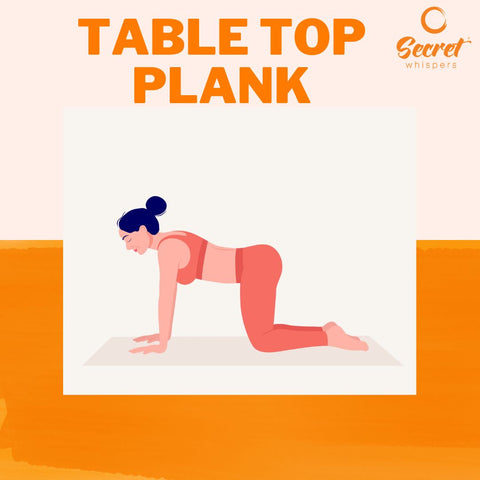Planking & The Pelvic Floor
Keeping a healthy pelvic floor is all about clever strength exercises that work the muscles in the area.
If you have a prolapse, it can feel like your internal organs have suddenly got very heavy and a pressing down towards your vagina. In sever cases, the prolapse can actually protrude outside the vagina.
As gravity takes its toll, the symptoms can get worse when you are standing up.
Childbirth, carrying a baby, and ageing can all cause prolapse of various internal organs. It is important to exercise fully using specific strengthening exercises to minimise the damage and the issues caused by a pelvic organ prolapse.
What Is Planking?
The plank is an exercise for developing core strength. The aim is to build strength by creating a straight line with your body resting on your toes and your forearms. Your elbows need to be directly under your shoulders and your forearms are facing forward. Your head should be relaxed and you should be looking at the floor.
If you've never tried a plank exercise, you may be surprised by how difficult it feels initially. It is designed to strengthen the muscles that support the spine around the trunk area.
But it also works your thigh and calf muscles, your chest and shoulder girdle, as well as the muscles in the middle of your back.
It is an exercise that requires practice and building up a tolerance. You should only aim to hold your planking pose for a few seconds initially, but over time, and with repetition, as your muscles get stronger, you can build up the amount of time you spend doing plank exercises.
Are Planks Good for Pelvic Floor?
Planking can be good for the pelvic floor, but there are a few caveats that you should take care of.
Some people report that it makes their symptoms seem worse for a few days afterwards.
However, if you begin strengthening your muscles using gravity in your favour, you may find it is a whole different ballgame. As we have discussed, standing up may make prolapses feel significantly worse because gravity is pulling everything down.
There are some variations you can try.
The Table Top Plank:

This plank variation is achieved by pressing into your hands and pulling up and in your abs. This helps you to learn how to keep your spine neutral like in the diagram above.
You can also then choose if you wish, to tuck your toes under and practice lifting your knees slightly off the floor. Doing a plank like this, were your knees are bent and lifted can help take some of the pressure off of your feet as you your core strength.
Forearm Plank On Knees

This is great for the transversus abdominus, which is the muscle that gives you a flatter belly. Aim to hold for 10 seconds and gradually over time aim to reach 60 seconds hold, 2 to 3 times a week.
- Start by lying on the floor with your forearms flat on the floor like the image above. Ensure that your elbows are aligned directly under your shoulders.
- Then engage your core and raise your body up off the floor while keeping your forearms and your knees on the floor and your body in a straight line from your head to your knees.
- Keep your abdominals engaged and try to to let your hips rise or drop.
Side Plank

Another exercise to look at when it comes to taking pressure off the abdominal and pelvic area is a side plank.
In this version of the exercise, you are supporting your weight on a single elbow with your body sideways and then on the side of your foot. Again it's important not to dive straight in and suddenly try and hold this position for as long as possible but begin slowly and build up your progress.
Side plank does not quite work the muscles in the same way, but it can be a valuable starting point so that when you do the standard plank, you have strength and stamina supporting muscles a bit more, and of course, while you are doing the exercise you are not putting anything like as much pressure on your pelvic region.
You can also modify the plank position by using your forearms and knees instead of your toes to balance. If you begin to slowly work through all the modifications, you will find that you are able to strengthen your muscles enough to perform a full plank.
Kneeling Side Plank

- Lie on your side with your knees bent and your legs stacked. Your elbow should be directly under your shoulder to support your torso.
- Form a bridge between your knees and forearms by lifting up your pelvis. This exercise works the abdominal and the oblique muscles.
- Hold your side plank and don't forget to keep breathing. Then exhale as you hinge from your hips to lower back down to the mat.
- Aim to hold the position for 60 seconds.
- Change sides and repeat.
If you start with short sessions and gradually build up the length of time, you may well discover that planking can be great for your pelvic floor recovery and is a good exercise to use in combination with others, such as your Kegel exercises.
Can You Plank with Kegel Weights?
Yes, you can plank with Kegel weights, provided that you take the advice given above. You should work with gravity, not against it; otherwise, you may find your symptoms initially start to get worse.
Basic Kegel exercises without weights can be done anywhere at any time, so you can also add a Kegel exercise to your plank. As with any form of exercise, you should pay attention to your body, and if you find that it is causing you significant discomfort, stop doing it.
Is It Safe to Plank with a Pelvic Organ Prolapse?
It is safe to do a plank when you have a pelvic organ prolapse, provided that you exercise care and remember that you currently have some damage to your body. You wouldn't try and run a marathon on a sprained ankle, so it's important that you use the same logic when exercising to help with pelvic organ prolapse.
Start slowly and build up the length of time you can hold the position. You know your body best so listen and adjust when necessary for you.
You should not do any form of planking exercise if you have had a Caesarean section before you are cleared by your medical team. It's also important to remember that you should never dive in and start trying to hold a plank for as long as you possibly can, as this can cause further injury.
It is also vital to pay attention to your breathing, as any breath-holding can make symptoms seem a lot worse. If you are effectively holding your breath, you are straining your muscles even harder.
TIP - If you count out loud you cannot hold your breath!
Another exercise to look at when it comes to taking pressure off the abdominal and pelvic area is a side plank.
In this version of the exercise, you are supporting your weight on a single elbow with your body sideways and then on the side of your foot. Again it's important not to dive straight in and suddenly try and hold this position for as long as possible but begin slowly and build up your progress.
Side plank does not quite work the muscles in the same way, but it can be a valuable starting point so that when you do the standard plank, you have strength and stamina supporting muscles a bit more, and of course, while you are doing the exercise you are not putting anything like as much pressure on your pelvic region.
You can also modify the plank position by using your forearms and knees instead of your toes to balance. If you begin to slowly work through all the modifications, you will find that you are able to strengthen your muscles enough to perform a full plank.
The Takeaway
Overall the plank is a great exercise to help with building muscle strength after pelvic prolapse, but you do need to ensure that you are performing it safely and modifying it to prevent any further injury or strain being faced on the area.
Start slowly and find what works for you.
It is important to remember that you are breathing throughout the exercise and not holding your breath, as this can make things worse. Remember the tip above - count out loud and then you can't hold your breath.
If you are interested in learning more about different exercises to help your prolapse and improve your pelvic floor strength - I am running the next 30 Day Pelvic Floor Challenge in March 2023.
Every day there is a new pelvic floor exercise for you to do. This challenge has helped so many women find what exercises work for them and have improved their pelvic floor strength.
➡️ You can also join our fabulous womens only private Facebook Group
➡️ Fancy a FREEBIE? Download our FREE guide The easy way to get a stronger pelvic floor
➡️ Sign Up Now - The 30 Day Pelvic Floor Challenge - Starts 20th March 2023. Limited spaces
Any questions? Just email us at support@secretwhispers.co.uk and we will get straight back to you.
Never miss another blog again. Sign up now to my weekly Newsletter. You will get a 10% discount code to use too.Just click below ⬇️⬇️⬇️












